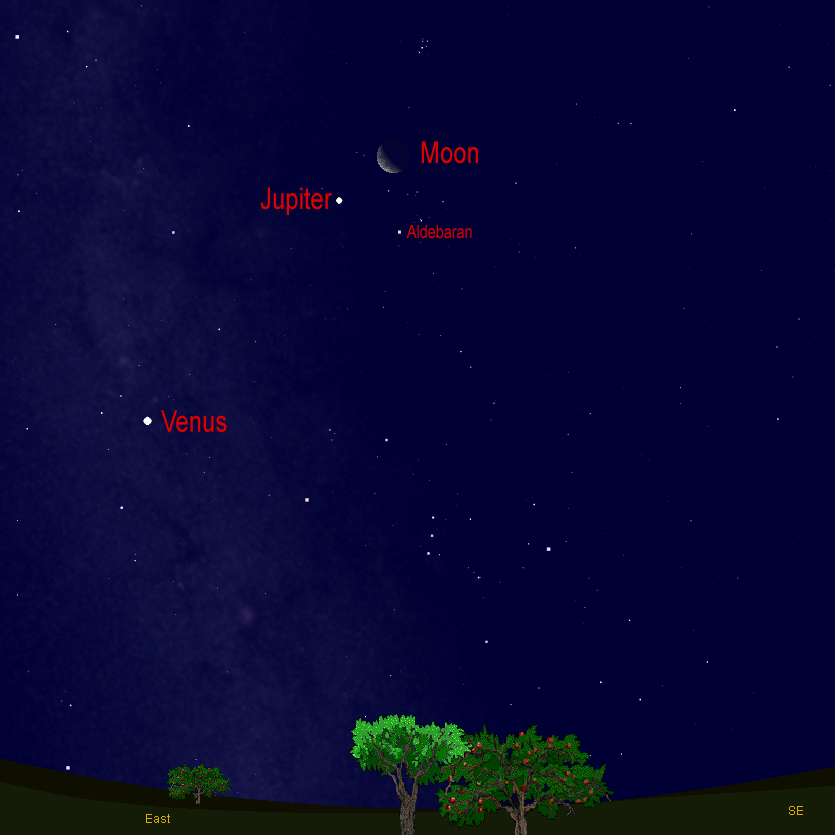
If you’re outside before sunrise on Saturday (Aug. 11) hoping to see a preview of this weekend's Perseid meteor shower, you'll be treated to a rather eye-catching array in the eastern sky.
Weather permitting, you'll be able to see a beautiful waning crescent moon, just 35 percent illuminated, accompanied by a brilliant silvery "star" hovering below and to the left of the moon. But that's not a star, but the largest planet in the solar system, Jupiter.
Jupiter currently rises in the east-northeast just before 1 a.m. local time. An hour later this planet and the moon are both in fine view low in the east, shining about 5 degrees apart — which is about half the width of a clenched fist held at arm's length. As the eastern sky begins lighting up with the break of dawn, Jupiter has climbed halfway up in the east.
This month, Jupiter is a bright predawn planet located in the constellation Taurus, near to the orange star Aldebaran and the 'V'-shaped Hyades star cluster. The Pleiades star cluster shines well above the celestial arrangement. [August Night Sky: 2012 Viewing Guide]
Jupiter adds its luster not only to the nearby crescent moon above it, but also to the brilliant planet Venus lower down, and also to all those bright winter stars that embellish theAugust predawn sky. For those who don’t like the cold, now is an excellent time to observe those winter luminaries under summer conditions. The Hyades will keep Jupiter company throughout its current apparition until May 2013.
Keep in mind that what you’ll be seeing is all a matter of perspective.
The moon will be just a stone’s throw away (relatively speaking) at a distance of 248,000 miles (399,000 km). Jupiter is nearly 2,000 times farther away at a distance of 495 million miles (797 million km). The Hyades are about 153 light-years away.
Get the Space.com Newsletter
Breaking space news, the latest updates on rocket launches, skywatching events and more!
Even though Aldebaran appears to be a member of the Hyades because of its perfect placement in the 'V' of this star cluster, it’s merely an innocent bystander, as it is less than half as close as the cluster at 65 light years away.
After Saturday, the moon will move on, eventually crossing paths with Venus on Monday (Aug. 13). Jupiter will slowly increase in prominence during the coming weeks and months, ultimately becoming a fixture in the upcoming fall and winter evening sky.
Joe Rao serves as an instructor and guest lecturer at New York's Hayden Planetarium. He writes about astronomy for The New York Times and other publications, and he is also an on-camera meteorologist for News 12 Westchester, New York.
Join our Space Forums to keep talking space on the latest missions, night sky and more! And if you have a news tip, correction or comment, let us know at: community@space.com.

Joe Rao is Space.com's skywatching columnist, as well as a veteran meteorologist and eclipse chaser who also serves as an instructor and guest lecturer at New York's Hayden Planetarium. He writes about astronomy for Natural History magazine, Sky & Telescope and other publications. Joe is an 8-time Emmy-nominated meteorologist who served the Putnam Valley region of New York for over 21 years. You can find him on Twitter and YouTube tracking lunar and solar eclipses, meteor showers and more. To find out Joe's latest project, visit him on Twitter.









